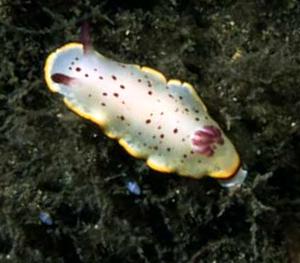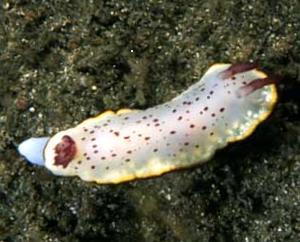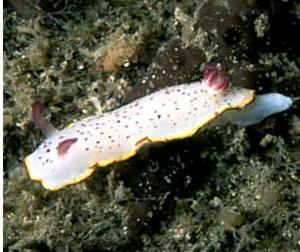Chromodoris daphne - where does it live?
January 5, 2001
From: Des Paroz

Dear Bill
A Happy New Year to you and all the participants in the Sea Slug Forum. Over the past few weeks I have taken advantage of the tides and general conditions, and have made a few dives at Shiprock [Port Hacking, Sydney, New South Wales].
On the first of these dives I found a species that I have not otherwise seen, which I believe to be Chromodoris daphne. On reviewing your site, I noticed that the only info relating to the species is your original entry with photos taken by you at Shiprock, some years back.
Is this species fond of sites with tidal flows? I noticed on Wayne Ellis' Nelson Bay species list that it is a species also found there. These photos were taken on a 2.0m high tide on Boxing Day, [Dec 26, 2000] and were photographed on a small rocky outcrop at the bottom of the wall in about 14m. Water temp was 24C.
Best regards
Des
des@paroz.com


Dear Des,
We haven't got that many records of C. daphne. Around Sydney, Shiprock, Port Hacking has been a place where it has been found, but that may be because it is regularly visited by divers. It has also been recorded at Watson's Bay in Sydney Harbour. Elsewhere in New South Wales it has been found at Fly Point in Port Stephens. There is a lot of tidal movement there but until areas without much tidal flow are investigated we can't say much. On the other hand it has also been found intertidally at Stradbroke Island in Moreton Bay in southern Queensland and on the southernmost reefs of the Great Barrier Reef.
With so little information available it is hard to say anything sensible about why or where you are likely to find a particular species. Where a species actually lives, in a particular geographic area, is the result of a complex of factors, not the least of which is the presence of its food. If its food is not present then larvae will not settle from the plankton, and after they settle, if there is not sufficient food they will die from starvation before they reach maturity. A critical factor then is whether the locality is suitable for the food organism to survive. I have a picture of many small juveniles of the pink Victorian colour form of Noumea haliclona. One time at Mallacoota, on the border between New South Wales and Victoria, in southeastern Australia, I came across a small rocky bay where the intertidal rocks were carpeted in a bright pink sponge which was infested with juvenile Noumea haliclona. This was seemingly an ideal spot for the sponge. There were many millions of animals of Noumea haliclona there. I returned a month later to find a storm had washed away all the sponge and no Noumea could be found. So what seemed a perfect spot for Noumea haliclona was in fact a death trap.
Basically it is difficult to determine where an animal will be found. That's what makes nudibranch fieldwork both exciting, but also very frustrating.
Best wishes,
Bill Rudman.
Related messages
-
Re: Chromodoris daphne from sthn Queensland
From: Denis Riek, January 23, 2009 -
Re: Chromodoris daphne feeding observation [2]
From: Leanne and David Atkinson, January 22, 2009 -
Chromodoris daphne from sthn Queensland
From: Gary Cobb, January 20, 2009 -
Re: Chromodoris daphne feeding observation [2]
From: Leanne & David Atkinson, January 19, 2009 -
Chromodoris daphne feeding observation [2]
From: Bill Rudman, November 27, 2006 -
Chromodoris daphne feeding
From: Leanne & David Atkinson, November 27, 2006 -
Chromodoris daphne laying eggs
From: Leanne & David Atkinson, March 27, 2006 -
Octopus & Chromodoris daphne
From: Sean P. McMahon, November 29, 2002 -
Re: Chromodoris daphne
From: Wayne Ellis, January 18, 2001
